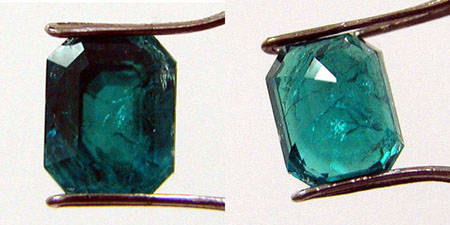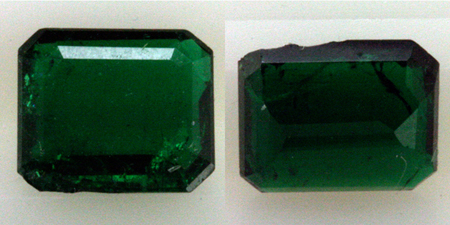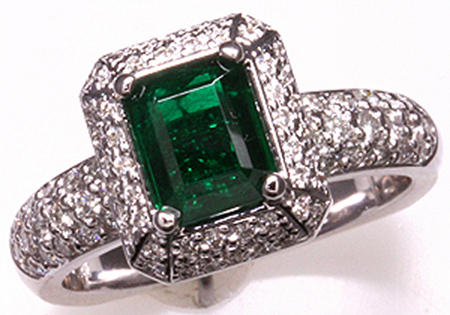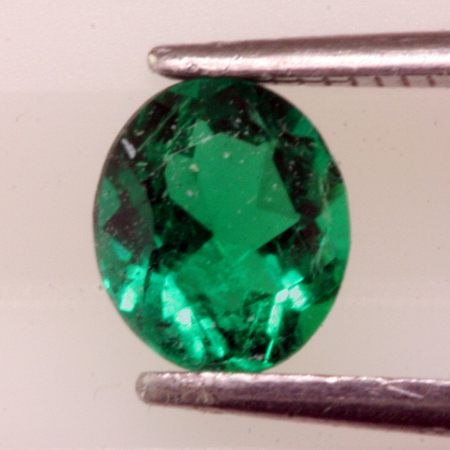Re-Cutting Emeralds- Resurrecting Beauty
May 16th, 2009 by James L. Sweaney, CGA, FGA. GGThe classic emerald is a beautiful gemstone with a reputation for fragility. When you understand the rigors that emeralds undergo during their formation, you’ll see that this reputation is mostly undeserved. Colombian emeralds, for example, form when ocean sediments are compressed under tectonic plates and then are metamorphosed and uplifted to the top of the Andes Mountains. When you think about the tremendous heat and pressure they are subjected to, it’s easy to see why emeralds typically have the internal inclusions and fissures known as “jardin”.
The results of several emerald re-cuts and repairs done by Mardon experts demonstrate that emeralds can truly take a lot of punishment, and that with the right skills, a damaged gem can be restored to it’s full beauty.
The image above, of a 2.54 ct. emerald we purchased from an estate, shows its original condition. Even though emerald has a hardness of 7.5 – 8, this gem, after a lifetime of wear, had developed a well-worn look somewhat like beach glass! Like all crystalline gem materials, including diamond, emeralds are brittle and can be damaged by the constant rubbing and hitting of daily wear on the hand. Recognizing the fine rich color of this “Gota de Aceite” (Drop of Oil) Muzo emerald, we decided to take a chance, purchase the stone and have it re-cut.
Along with the re-cut, we also chose to have the emerald cleaned of oils and resins. Since the time of Cleopatra, virtually all emeralds have been enhanced by soaking in various oils and/or resins, from oil of balsam to epoxy type resins, which closely match the optical properties of emerald. When these oils penetrate into the “jardin” of the emerald, the inclusions become much less visible—it’s like dropping a clear ice cube into a glass of water—the optical properties match, so the ice cube disappears!

2.54 ct Muzo emerald, recut to 2.29 ct, front and back, unenhanced
After the re-cut, we re-enhanced the emerald by the Excel process, a proprietary enhancement that is similar to but much more stable and durable than traditional oil or resin methods. The photos above show the stone, front and back, after cleaning and recutting, but before the Excel re-enhancement. Compare the more prominent appearance of the “jardin” in its un-enhanced state to the photo below of the stone after enhancement.
Here is the gorgeous finished 2.29 ct. gem in its current setting, where it resides on the hand of my wife! An added benefit of the re-cut–with the Excel enhancement, we’re able to clean the stone frequently, even in an ultrasonic, without worry—The Excel process is stable and guaranteed for life!
This African emerald was in an exposed mounting where it became badly chipped along one side—the view from the pavilion (right photo) shows the damage more clearly.

African Emerald damage, front and back views
We had the stone recut and enhanced by the experts at Excel, then we reset it into this beautiful ring—though over-dark, the emerald shows to its maximum potential and beauty. Additionally, this setting will protect the stone much better than did the original.

African Emerald, restored to full beauty
Finally, this lovely Brazilian emerald, a round stone weighing .83 ct, was badly damaged by excessive love—daily wear by a doctor who works in the operating room—and looked to be a total loss. You can see the more obvious chips along the top and right side.
Our experts were able to re-cut the stone into this lovely oval .76 ct, losing less than 10% of the weight!

.76 ct. Brazilian emerald, fully restored
The moral of the story is that while emeralds and most other gems are valued for their beauty, rarity, and durability, they are not indestructible. Most crystalline gems including diamonds, are brittle, meaning that they have no flexibility and can be broken. On the other hand, their strong crystalline structure allows them to endure scratching, changes in pressure and heat, and corrosive environments, so that they can be recut numerous times.
Gem lore has it that in ancient times, rubies were used as ammo in muzzle-loaded firearms because their properties of strength were thought to bring victory on the battlefield. If your stone looks like it was shot from a gun, our gemologists will help you evaluate its potential to become magically beautiful once more. You can see from these examples that we can work wonders. If you own a damaged gemstone, bring it in for an expert consultation—call for an appointment with Jim today!
Tags: African emerald, Brazilian emerald, Colombian emerald, Excel enhancement, gem enhancement, gem recutting, Gota de Aceite, Muzo, oiling emeralds







